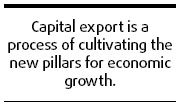Zhang Monan
Nation should be more efficient in capital use
Updated: 2009-01-08 07:39
By Zhang Monan (China Daily)
The reform and opening up has changed the course of contemporary China. The historical decision embraced 30 years ago was originally applied to the country's processing trade, introduction of foreign fund, exploration of resources, and the compensation trade.
It served as the best option during that period of certain historical conditions. Thanks to the "cultural revolution" (1966-76), the country's economy stayed stuck at a low level. The country had no choice but to resort to foreign capital to offset its lack of capital and advanced technologies and its inability to be integrated into the global economy.
However, such a low-end economic development model meant that developed countries, through capital outflow and direct or indirect outward investment, could acquire larger shares in the distribution of international capital returns.
Since then China has taken an increasing proportion of the global capital market and now possesses a total of $50 trillion banking assets and $1.9 trillion in foreign reserves. However, a large sum has not changed its character of low-quality capital and this has posed a severe challenge to the country's colossal but weakly founded economic and financial pattern. Thus, how to push for a substantive shift to its capital operation model and improve its competitiveness in the global capital market is of strategic significance for the country's peace and development.
Over the past 20 years, global gross domestic product has witnessed a 3.5 percent annual growth rate, while the international trade volume rose by 7 percent and the flow of international capital by 14 percent. However, as a result of the accelerated international capital movement, the US has successfully leveraged its overwhelming capital superiority and set up the dollar-dominant global capital division system.

The country has experienced global industrial and trade division steps since adopting the reform and opening up policy. In this process, the US has successfully transferred some of its traditional manufacturing industries and low-end services to developing countries, especially to emerging economies possessing resources and cost advantage, as well as bigger market potential and better industrial logistics capability.
An increasing number of developing nations have been included in the global labor division system dominated by developed nations-run transnational corporations. Most Asian countries, including China, have increasingly become the base of global manufacturing industries and the region's trade volume has been on the rise in the global aggregate and its trade surplus has been further expanded.
Developed countries represented by the US have been in a position to manipulate the global financial system. As the most powerful country, the US has taken advantage of its No 1 position in the global financial chain and in the process of international capital movement, and succeeded in forging a worldwide production, consumption and investment process to its benefit. It has also gone all out to transfer its home capital to developing countries. However, these countries' increasing amount of reserve capital, induced by their expanding trade surplus, will once again flow to the US in the process of international capital movement.
This kind of a model for international financial division has resulted in an unbalanced international capital distribution. Due to its superior status in international trade settlement and foreign reserves, dollar capital has also acquired a dominant position in the global financial configuration.
Under these circumstances, it remains a pressing task for China to see how it can break its prolonged cycle of low-efficiency and high-risk capital, change the world's unbalanced profit distribution in the process of international capital movement and gain an advantage in the global financial division system. The most immediate challenge is to substantively improve the country's capital utilization efficiency, upgrade industrial structure and boost capital competitiveness.
The country should also outline an unequivocal road to promote an essential shift of its economic development strategy from commodity export to capital export. Capital export is a higher level of economic development and resource allocation. China's capital export should not only be aimed at easing its foreign reserve excess and curbing trade surplus, but also become its core financial development strategy.
The world's practices show that a country should increase its net outward investment when it reaches a certain economic level. In this process, the key is to increase investment returns and raise its international competition advantage. According to a Swiss bank data, China's per capita gross national product in 2007 was $4,610, a stage that heralds a large-scale outflow of the country's capital. However, compared with the inflow of international capital, the country's $18.72 billion outward-bound capital last year was still on a small scale and its potential in the regard is yet to be further expanded.
The success of a country's economy rests with its accumulated capital capability and resources utilization efficiency. Only home capital, not foreign capital, can bolster its industrialization process longer. Thus, China should push for an internally driven economic growth, and shift to a strategy of letting capital "go out" from the past one of "letting capital in". Capital export is a process of cultivating the new pillars for economic growth.
China should sharpen its capital competition edge in the global market and change its status from the world's factory to the world's capital source. Only a strengthened capital allocation capability in the global capital market can help the country take an overall economic leap.
The author is an economics researcher with the State Information Center
(China Daily 01/08/2009 page8)
Specials

President Hu visits the US
President Hu Jintao is on a state visit to the US from Jan 18 to 21.

Ancient life
The discovery of the fossile of a female pterosaur nicknamed as Mrs T and her un-laid egg are shedding new light on ancient mysteries.

Economic figures
China's GDP growth jumped 10.3 percent year-on-year in 2010, boosted by a faster-than-expected 9.8 percent expansion in the fourth quarter.